Limit switches are special devices that allow you to turn off the power supply from the actuator at the right time. Another name for these devices is "switch-type limit switch", which is explained by the specifics of mounting their holders at the end sections of movement. To understand the features of work, it is important to familiarize yourself with the design of this type of switching products.
Design features
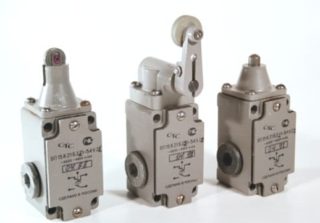
The limit switch used in electrical circuits is an electrical device that in its functions resembles a conventional switching device. The difference from the familiar to all products lies in the specifics of the application and the associated design features. Since they are triggered only at the final section of movement, a special rod is provided on their body, which fixes the moment when the control position is reached.
The modern limit switch is equipped with non-contact means of position detection, including inductive or capacitive sensors.
Technologically advanced designs with inductive and capacitive sensors greatly simplify installation and increase the reliability of actuators, reducing their cost and extending their service life.
Areas of use
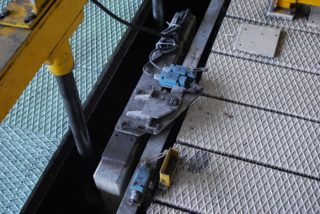
The known types of limit switches are in demand in various fields of human activity. According to their functional focus, they are divided into the following types:
- protective action limit switches;
- devices for individual use.
The first ones are mounted in order to protect mechanisms and people from actions that are not provided for by the rules for operating the devices. For example, elevator mechanisms are not set in motion until their door curtains are fully closed. Their main purpose is to ensure human safety when using various mechanisms.
Devices for individual use are used in household appliances or industrial units, where it is required to fix a certain moment of movement. When the doors of the refrigerator are closed, the lighting in it is turned off by a contact switch, and when opened, it is turned on again.
In the general case, the scope of the devices is all those places where it is necessary to restrict movement with some kind of framework. One of the options is to control the position of the device valve, which blocks inadmissible mechanical movements.
When installing the limit switch in the swing door control chain, for example, it is fixed on self-tapping screws inside the cabinet built into the wall. When closed, the door body presses the control button, opening the electrical circuit for lighting the interior spaces. When it is opened, the push-button contact is restored and closes the working circuit, after which the light comes on.
Classification by principle of action
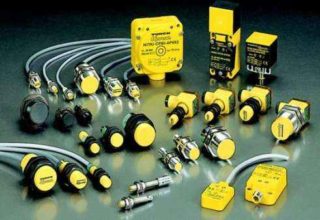
According to the principle of their action, limit switches are divided into three main groups:
- electrical contact switches;
- contactless devices;
- magnetic devices.
The operation of mechanical switches is based on the direct impact of the tip on the actuator of the electric drive, interrupting the power supply due to direct contact with it.An example of contact limit switches are mechanisms that are triggered when a car door or garage door is closed.
A feature of non-contact devices is the transfer of energy to the sensors of the following types:
- inductive end sensors;
- capacitive sensitive elements;
- ultrasonic and optical sensors.
Taking into account the type of the sensor built into the switches, they are installed in certain executive circuits.
Magnetic limit switches
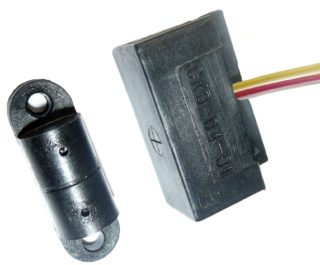
A special place is occupied by sensitive devices that are triggered by a magnetic field. These products, also called reed switches, are replacing the mechanical models of switches. Their ferromagnetic contacts, placed in a glass bulb, close or open when a permanent magnet is placed next to it. Due to its simplified design, the dimensions of this device are very small, so that it can be easily mounted in a controlled circuit break.
The contacts in it are normally closed, as well as normally open or switchable, and the choice of a particular type depends on the nature of the movement, including the reverse mode.
When installing magnetic reed switches, be sure to take into account their polarity. If the poles are confused, they will not work.
Magnetic limit switches are widely used in sliding gates. Some models are part of the executive unit of the security alarm system mounted at the entrance to the house. Often these devices are installed in modern furniture to control interior lighting, for example. The built-in furniture light switch is the most convincing example of their effectiveness. The absence of mechanical contacts in such a design is its indisputable advantage, which contributes to the extension of the product's service life.
Connection procedure and specifics
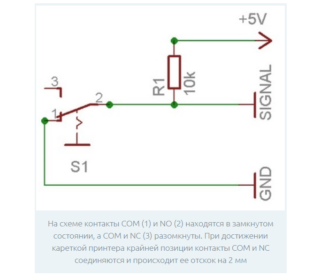
Although the limit microswitch itself is quite simple, it can be used in technological equipment saturated with electronics. From this it follows that an experienced specialist who is well versed in the switching circuits of electronic components should connect it.
A typical example of such a connection is the installation of a mechanical switch in a typical 3D printer, during the operation of which it is required to fix the extreme position of the carriage. The mounted switch has 3 contacts with the following designations: COM, NO, NC. In the open state, the first and third terminals have a voltage of +5 Volts (while the second contact is reliably grounded). When the movable carriage reaches the end position between COM and NC, a connection appears, after which it is fixed and rebounded by about 2 mm.
Such a sensor is connected by means of two conductors in red and black insulation. When installing another type of switch (with an indicator), a more complex circuit is used, in which another conductor is provided - in green insulation. When the micro-switches of the push type in the printers are triggered, the LED lights up and a characteristic click is heard. Its connector, located on the commutation board, has special designations:
- the red wire is marked as V (+5 Volts) and serves to connect the corresponding voltage;
- the black conductor is connected to the point G (or ground);
- S (signal) is selected for the green bus.
The same signs are also found on the optical limit switch connector, which more accurately fixes the position of the carriage.
It works completely silently, reaching the extreme position is accompanied by LED indication. Its disadvantages include the possibility of malfunctions in case of strong dust or exposure to direct sunlight.
Instructions for connecting magnetic sensors are given in the passport for furniture sets that have limit switches in their design. The attached diagram usually indicates the attachment point of the plastic case with the switch control key.For a door located in the middle of the cabinet, the device is installed in such a way that it does not interfere with the normal shutter of the other door leaf.
Limit switch marking
Microswitches and microswitches, regardless of their characteristics, have specific markings. After decoding it, it is possible to obtain all the information about each model of the limit switch. If an entry of the "VU222M" type is found on it, this indicates a switch of the corresponding series. As an example, we will decipher the marking of a widespread product of the VP 15M4221-54U2 brand. It means that its design contains one movable element of the 15 series, as well as one NO and one NC contact.

All switching elements in this series are controlled by a roller pusher built into the housing.
The degree of protection on the drive side of the structure corresponds to IP54, and the "U" symbol means climatic modification. The next number 2 is the category of product placement, which corresponds to TU U 31.2-25019584-005.
Leading manufacturers
Many companies are engaged in the release of terminal sensors. The recognized leader is the German company Sick, which is considered the main manufacturer of this class of products. Another well-known company, Autonics, is engaged in the production of inductive and capacitive proximity switches. Inexpensive sensors of the same class and of sufficiently high quality are also produced by a Russian company called "TEKO". Its products are distinguished by a high degree of tightness (IP68), which allows them to be used in especially hazardous environments.
Limit switches "Promfaktor" from Ukraine have also proven themselves quite well in the Russian markets. This manufacturer produces switching devices under the designations VP, PP and VU. All of these products have a 3-year warranty.








